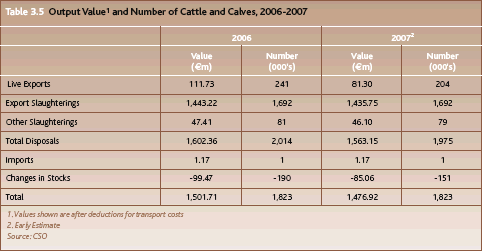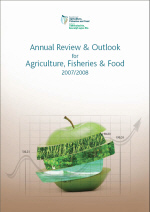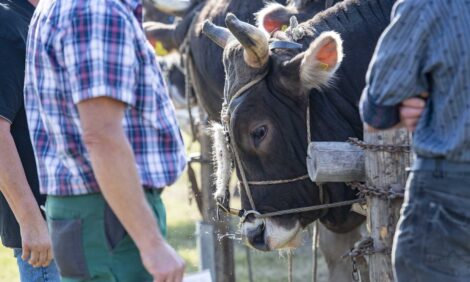



Ireland: Annual Review & Outlook for Agriculture, Fisheries & Food 2007/2008 (Beef)
This report is an extract taken from the Annual Review & Outlook for Agriculture, Fisheries & Food 2007/2008, examining the beef market situation in Ireland. It was published by the Irish Department or Agriculture Fisheries and Food.Cattle
General Market Situation 2007
2007 was a challenging year on both Irish and EU beef markets. Beef production in the EU 15 continued to decline, with the supply shortfall widening further, while domestic production rose marginally, due largely to a small increase in average carcase weights.
Slaughterings at Irish export plants were virtually unchanged with the net result that output grew by 1.5% to 578,000 tonnes. Exports to both the UK and Continental Europe continued to grow with third country trade declining further. Despite a recovery in the latter part of the year, prices eased somewhat during 2007. Restrictions in relation to the import of Brazilian beef into the EU were announced in December. A significant increase in input costs, particularly grain, was witnessed in 2007 but this has yet to feed into retail prices. Notwithstanding this, and the continued presence, in a somewhat restricted form, of low-cost South American offerings in our competitor markets, the outlook remains positive for 2008.
Output in Ireland
In 2007, the output value of the beef sector decreased slightly (1.6% approx) to just under €1.5 billion. This was primarily a reflection of a slight decrease in the volume of live exports and a slight easing in prices compared to 2006.

Prices
The upward trend in beef prices witnessed in recent years came to an end during 2007. Average prices across all categories eased, reflecting more challenging trading conditions in Europe, a significant decline in international trade, particularly with Russia, and the continued presence of cheaper South American cuts in our principal markets, especially in the early part of the year. Cattle prices responded to these factors with the three main categories experiencing a decline in prices, although there was some evidence of stabilisation as the year progressed (see Figure 3.4). Steers fell by almost 2%, heifers were down about 1%, while cow prices were back by around 3%. Notwithstanding this, average prices during 2007 remained almost 5% above 2005 levels. Furthermore, relative to EU-15 averages, Irish steer R3 prices made comparative gains and rose to 92% of the EU weighted average price during 2007, compared with 89% in 2006.
Slaughterings
Cattle throughput at meat export premises during 2007 at just under 1.7 million head was virtually unchanged compared to 2006. However, a small rise in average carcase weights resulted in a small increase in total production (see Figure 3.5).
Live Cattle Exports
Exports of live cattle fell by almost 17% during 2007 reaching just under 208,000 head. Following the abolition of export refunds on these exports, practically all of this trade is with other EU Member States. Live exports to the UK increased by almost 30%, but shipments to our largest Continental EU markets declined by one-fifth. The main reasons for this decrease included a slow veal trade, higher feed costs and lower cattle prices. Our principal Continental markets remain Spain, Italy and the Netherlands (see Figure 3.6).
Beef Exports
Beef exports continued to increase, albeit at a slower level than in recent years. 2007 saw further consolidation of the Irish beef position in the higher value Continental EU markets with almost 235,000 tonnes being exported – an all-time high and represents a sixth consecutive year of growth. Despite the increasing competitive challenge posed by South American competitors, particularly at retail level, volumes increased in all major markets except Italy. The UK remains our largest single market realising a 4% increase last year to over 275,000 tonnes. This occurred in spite of increased volumes of UK beef on the market following the foot and mouth outbreaks.
Exports to international markets declined during 2007 with Russia remaining the principal such destination. The net result of these trends is that more than 95% of our exports now go to the highvalue internal EU marketplace.
Third Country Developments
The suspension of beef imports from certain states in Brazil due to Foot and Mouth disease (FMD) continued during 2007. These regions were the source of almost three-quarters of Brazilian beef exports prior to the outbreak. Consequently, imports of beef from Brazil to both the EU and Ireland declined slightly during 2007, although Brazil remained the largest single international supplier to the EU. The continuation of the self-imposed restrictions on beef exports from Argentina contributed to a small decline in this trade. The decision to restrict exports from Brazil, taken in December, is expected to have a significant impact on trade during 2008.

Despite the continuation of the shift in Irish exports towards Continental Europe, efforts continued during 2007 to reopen international markets. Both the Saudi Arabian and South African markets were reopened during 2007 and discussions are well advanced with a number of countries including Indonesia, Singapore, the Philippines and Japan. A Market Access Group has also been established to facilitate trade in Irish beef to non-EU markets.
Outlook 2008
The level of live trade, particularly during 2006 will have a knock-on effect on finished cattle supplies to meat plants particularly during the first half of 2008. In addition, the increased number of marketings during the final quarter of 2007, which would normally not be expected until the spring, will further tighten supply. As a consequence export supplies are expected to fall by around 35,000 tonnes. However, the prospects for Irish beef exports still remain positive. While the impact of the restrictions on Brazilian imports is difficult to ascertain, these are likely to significantly impact on import volumes. In addition, the increasing supply deficit in the EU should continue to provide a more solid market environment for Irish beef. Notwithstanding this, the UK will remain our largest single market, due largely to an increasing import requirement. Domestically, given the forecast decline in production, prices should remain strong. The ongoing WTO negotiations are very important from the beef perspective and any agreement is likely to impact on projections.
Further Reading
| - | You can view the full report by clicking here. |
July 2008




